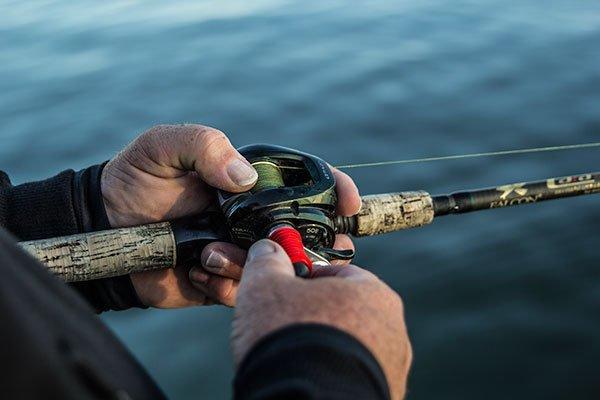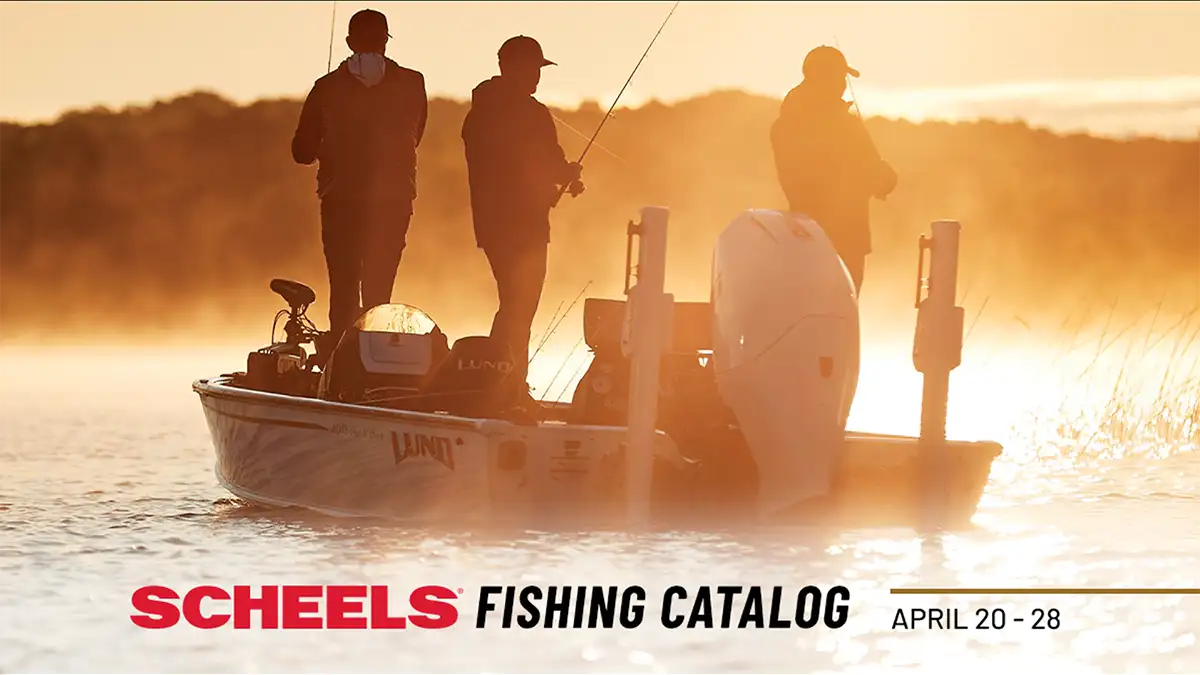Learning how to fish bass fishing lures involves knowing how to impart the intended and often erratic action necessary on the retrieval of the lure to get a bass to bite something fake in the water. It’s part casting to get it near the bass and then the rest is your presentation which is how you work the lure back to the boat.
Essentially there are two ways to retrieve a fishing lure or impart action on a lure in the water:
- Wind the lure in with your reel
- Move the lure along with your rod
Just as lures can basically be categorized as reaction baits and contact baits, retrieves can be characterized as reeling and rod pulling. I suppose you could hand wind a fish in with no rod or reel, but that sort of takes the fun out of the fight for us. But otherwise, here are some basic tips for both rod and reel retrieves.
Reel retrieves
Retrieving a lure a with your reel is the easiest to learn. And as you might guess, you basically cast the lure to, or past, a likely target or area and start turning the reel handle.
Essentially reel retrieves are for lures that require constant motion to give the lure action. A crankbait wiggles under a constant retrieve. A spinnerbait’s blade spins under constant reeling. A buzzbait’s prop churns under constant retrieve. A swimbait’s tail kicks and thumps under slow constant reeling. So these baits gain their action from the steady turning of the reel handle.
But as you might guess there are variances that can make it more efficient. Here are four factors to consider on reel retrieves:
Speed
While speed seems fairly simple—the faster you reel, the faster the lure gets back to you—speed is relative. Take a buzzbait for instance. You want to make a long cast along cover that you think bass are laying near to ambush prey. You want to reel it pretty quick to get it back up on the surface, but then you want to slow it down and reel it just fast enough that it’s staying up on the surface. The faster you reel it, the more you change its pitch and splash. So the speed may seem faster than other retrieves but slower than wide open. So like we say, speed is relative.
Stop
A simple instigating move you can do with the reel is, well, nothing. Just stop reeling for a second. A lure like a spinnerbait will be humming along, blades spinning. Then you abruptly stop reeling. The skirt that was flared back now relaxes and sort of pulses in the water, the blades stop and change direction.
Then just as immediately start reeling again. The blades will clank together and make a sound. The skirt will flare back in a fleeing fashion and now that ordinary minnow, looks like a spooky prey. Many pros have long preached about the importance of changing your cadence and popping and twitching and stopping and going in your every day retrieves to trigger strikes.
Gear Ratio
The gear-ratio of a reel can dictate how fast or slow you turn the reel. A 7:1 gear ratio reel might take up 30 inches of line in a single handle turn while a 5.4:1 gear ratio reel might only take up 20 inches of line on the same handle turn. So as you turn the handle at certain cadence or speed, your lure’s speed in the water is still determined by gear ratio in combination with the speed your hand is winding.
Keep that in mind as you switch between rods and reels. You might find they are crushing a spinnerbait on a 7:1 reel when you burn it under the surface, but you pick up a swimbait on a 5.4:1 reel and you can’t get the same reaction because even though you are winding it just as fast, it’s not coming through the water as fast.
Torque
You put a 20-foot deep-diving crankbait on a 7:1 gear ratio reel and make long casts and wind it back as hard as you can, you’ll be wore out in a couple of hours. It’s because the 7:1 reel transfers a lot of the torque to your hands and arms. When you gear down to a 5:1 reel, the torque is taken up by the lower gearing and you can wind it at a pretty good clip without feeling like the lure is pulling back quite so hard.
Reels enable the designed action of many lures. Rods however allow the angler to create their own actions.
Use the rod to impart action
Where a reel allows the intended action of a lure to happen, a rod can impart action to a lures that would have no action themselves. You can make a jig jump off the bottom of the lake. You can make a jerkbait dart and dance. You can make a topwater chug water or walk-the-dog until a big bass bites. You can crawl a plastic worm through branches of a laydown or stems of grass. All of these baits are fished primarily with the rod. And the reel becomes a mechanism to take up your slack line.
Here is a real basic overview of some simple rod retrieves you can do with your lures to give them more action.
Drag and reel
Usually when you’re fishing a lure with your rod, it means you need to add action to the lure to make it enticing to bass. The lure needs to do something that looks very natural, appealing to the bass’s hunger, or the lure needs to something very erratic, appealing to the bass’s aggression.
A drag and reel presentation with the rod preys on the bass’s hunger. You basically want to raise your rod tip very slowly, like a couple inches a second slowly. When your rod tip gets to about 10 or 11 o’clock, stop and feel for any movement. If nothing, then lower your rod tip back to 8 or 9 o’clock and as you do, reel up the slack line that is created as you lower your rod tip.
Then repeat. The key is to slowly pull your rod up so that the bait “scrapes” along the bottom. If you’re fishing over cover, you might have to shake your rod or just barely pop it to get it to jump oever the obstacle, but you are focusing on making the lure look like a crawling creature that never gets off the bottom. It’s slow and methodical, but to a bass it’s what forage along the bottom looks like to them when they are looking for a bite to eat. Feel your lure scrape over every rock.
Dance a jig
You can pop your rod tip upward, usually on a partially slack line, meaning you don’t have the line pulled up tight when you go to jerk; there will be a slight bow in your line and you sort of snap the slack out of the line with a small jerk.
If you think how a crawfish moves about. It crawls along on the bottom. But then it will hop up off the bottom and then glide back, sinking almost like a feather back to the bottom. They often scoot up off the bottom in a series of 3 short hops and then fall slowly back to the bottom. So think about that when you dance your jig.
Pop the slack three times in a row and then let the bait settle back to the bottom. Then repeat.
Lift and drop
An early way anglers found to fish soft plastics was with a simple lift and drop. For some reason this has become a forgotten technique and it works with a lot more than just soft plastics.
But many lures that flutter on the fall, or fall almost weightlessly to the bottom, lifting them is simply a means to an end. You life the bait up and the let it fall back to the bottom on slack or semi-slack line watching the line on the surface for any twitch or jump of the line.
How you lift the lure is as important as the drop. Sometimes you pull it up slowly. Sometimes you swim it up and let it fall back. Some times you use short pops to pop it up and then let fall and some times you rip it up and let it fall. All of these variations are essentially still a lift and drop retrieve.
If I’m fishing a plastic worm, I will often just swim it up a foot and let is float back to the bottom. If I’m fishing a jig, I might rip it off the bottom and let it fall trying to get a reaction. Same with a jigging spoon or a big flutter spoon. I will rip it up and then let it flutter randomly back to the bottom before repeating.
With the lift and drop, often the key is not how you get the lure off the bottom, but that you get the lure off the bottom so it can float naturally back.
Snap, Snap, Pause
You might want to impart some action on a lure under the surface or even on top of the surface. Something like a topwater popper or a jerkbait, needs the angler to give it action. This is best accomplished with a series of twitches, small jerks, wrist snaps or other short sharp movements followed by pauses or a delay for you repeat a series of movements again.
For a popper I might pop it hard one time and let it sit. Then pop it short two or three times and let it sit. I’m trying to draw a fish’s attention and then let him sit and stare at the bait before I make another erratic move to tell that fish the bait is alive but struggling.
With a jerkbait, you will hear anglers talk about cadence. That’s essentially nothing more than a series of jerks and pauses combined and repeated. So I might give the jerkbait 3 quick jerks and then let it sit for 5 seconds, then give it one jerk and let it sit 3 seconds. Then repeat that formula over and over again. That cadence helps to slow you down as an angler and fish the bait thoroughly and gives the fish quick movements and pauses to react to.
The key with these type retrieves is jerking on slack or semi slack line and reeling the slack up in between your jerks. It takes a little practice to get your timing down for reeling slack and jerking without the line being perfectly tight. Also you need to jerk and snap your rod back to the starting position, because the slack you give the lure back after the jerk is what allows the bait to duck and dart. If it doesn’t have slack on the jerk, the lure will just inch forward on a tight line.
Walk the dog
See this great video example of walking the dog
This is a famous retrieve for topwater walking baits like the bait that made it famous, the Heddon Zara Spook. It’s much like the jerk jerk pause retrieve except you just keep the cadence of jerks and reels going together all the way back to the boat.
The key is to snap the line with a downward jerk of the rod tip, and immediately point the rod tip back at the lure. Doing this will pull the bait at an angle and giving it slack will allow it to continue to glide to one side. Then on the next jerk you snap the line and the bait will knife back the other direction and as you point the rod back towards the lure it will glide the opposite direction.
It takes time to work on your snaps and reels but as you get into a rhythm it becomes effortless to make a topwater bait walk back and forth on the surface.
With these retrieves you can fish just about every bass fishing lure made. To learn more, check out our article on How to Detect Bites While Fishing.
For more information on bass fishing, see our How to Bass Fish Guide, When to Bass Fish Guide and Where to Bass Fish Guide.
—












